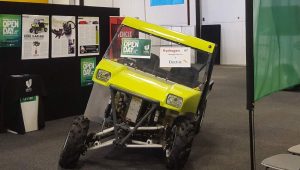Designing and building the UniQuad – New Zealand’s first hydrogen fuel cell electric vehicle – took former Unitec student and lecturer Simon Hartley thousands of hours, sandwiched between full-time work and study. Earlier this month, he finally showed off the result at the EVworld NZ expo.
The UniQuad is a four-wheel farm bike like no other. Driven by electric motors, the UniQuad has a range of 100km when running solely on battery power, and the hydrogen fuel cells (HFC) boost this to an impressive 600-700km. Hartley also ramped up the safety to tackle the high accident rate related to four-wheeled farm motorbikes, commonly known as quad bikes.
The prototype vehicle was the only one of its kind at EVworld NZ, an annual Auckland-based electric vehicle expo showcasing the likes of cars, e-bikes and e-scooters. Hartley says there were other utility vehicles, but none with HFC – or active self-levelling suspension, which can prevent vehicle roll-overs so common with quad bikes in New Zealand.
“Agriculture is second only to forestry in the number of workplace fatalities each year; farm vehicles in general and quad bikes in particular are problematic,” he explains.
“Currently there are 80,000-100,000 quad bikes in use around the country. According to WorkSafe, each year on average five people die and there are more than 100 severe injuries while using quad bikes on New Zealand farms.
“Quad bikes are often used on steep gradients and rough terrain, so they’re at high risk of rolling over. I’ve addressed these concerns by designing a safer, renewable-energy utility vehicle for New Zealand’s rural sector.”
Hydrogen fuel cells and high-tech driving

The UniQuad shows off its ability to adjust to angles at EVworld NZ.
He’s set the bar pretty high, too. Hartley says the UniQuad will comfortably drive on terrain people can’t walk on, such as 45-degree slopes. By comparison, Dunedin’s Baldwin Street clocks in at approximately 25 degrees. It’s recognised by the Guinness Book of Records as the steepest residential street in the world.
However, creating such a safe and sustainable vehicle didn’t come easily. Hartley researched this topic during his Unitec degree in Automotive Engineering. Building on engineering professor Jonathan Lever’s knowledge of hydrogen as a disruptive technology, Hartley focused on design and development for his Master of Design at Unitec in 2015-16.
“The biggest challenge was the scale of the project. Because I tried to do it all myself, it took 10,000 hours and it was relentless. Working full time and studying full time, and doing the UniQuad, meant I was up at 6am and often going to bed at 3am for a couple of years. That was very, very exhausting,” Hartley says.
“None of the technologies that I wanted to implement were available or documented. There were no books about self-levelling suspension or building a HFC. When I tried to apply new knowledge to existing knowledge, often they conflicted.”
Hartley built large parts of the HFC himself, because HFC are normally used in stationary situations for telecommunications. Adapting HFC for use in a moving vehicle meant designing ways to cool the cells and cushion them from vibrations.
Four electric hub motors power the UniQuad and are managed using what Hartley calls “intelligent 4WD”. The vehicle can adjust individual wheel speeds if the wheels are spinning and unable to get a grip on the ground, reducing the chance of accidents. The UniQuad also features zero radius turning, meaning it can turn around on the spot. No cars currently on the market can do this.
“When I actually finished it, I found it outperformed my expectations in terms of stability and speed, and how smooth it would be to drive. It’s very nice to drive!”
Huge market potential

UniQuad inventor Simon Hartley believes there’s huge potential for preventing and reducing injuries and fatalities from quad bikes.
Agriculture isn’t the only industry that could benefit from the UniQuad. Hartley sees potential use in forestry, mining and recreation too, here and overseas.
“Currently, the mass production cost is 2-4 times that of a conventional quad bike. However, in five years’ time the cost of hydrogen fuel cells will drop, allowing us to compete with current vehicles,” he says.
“The market is substantial: up to 100,000 units for New Zealand alone, and potentially 100 million units globally.”
Though the UniQuad can reach a speed of nearly 200km per hour, Hartley used software to limit the vehicle’s speed to approximately 60km per hour for safety. He’s currently tweaking the suspension and electric drive trains, and is open to interest from companies interested in working with him and Unitec to commercialise the UniQuad.
“There’s huge potential here for preventing and reducing injuries and fatalities. Every year, approximately 850 Kiwis are injured on quad bikes, and quad-bike accidents cost $10 million in ACC claims,” he says.
“That’s even before you think about the pain and disruption to people’s lives. I would love to see a reduction in accidents.”
With a day job at AUT, a research partnership at Unitec and his own consulting work around HFC, there seems to be little chance of Hartley getting a sleep-in any time soon. But the relevance of his work keeps him fired up.
The UniQuad will be on show at Unitec’s Mt Albert campus during the 2018 open day, Saturday 1 September. Register for the open day.
Learn about studying for a Bachelor of Applied Technology in Automotive Engineering at Unitec.




